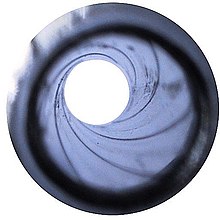Tension
The pull measure indicates the distance between two opposing trains in the barrel of a firearm .
The draft is always larger than the field dimension. The field dimension is, in turn, slightly narrower than the dimension of the caliber , i.e. the actual bullet diameter.
The mnemonic with which gunsmith (-Lehrlinge) noted that the Zugmaß is always greater than the surveyor, is: "The train runs through the field."
functionality
The jacket material or the guide ring (s) of the projectile are deformed by the fields and trains in the barrel during the shot . The somewhat under-caliber fields displace part of the material in the somewhat over-caliber trains. This results in little chip removal and "smear effects" of the projectile material. The pull dimension ensures that the projectile material is pressed sufficiently into the pulls so that the torque required to rotate the projectile can be transmitted. Twist and exit speed determine the rotational speed of the projectile; It is, for example, up to 300,000 revolutions per minute in handguns (higher rotational speeds often lead to the loss of the projectile due to self-destruction). The weight of the projectile determines the forces to be transmitted by the gun pulls.
The field dimension is slightly smaller than the projectile diameter. This creates the seal in the barrel . If the field dimension is larger than the projectile diameter, there is a loss of gas pressure, gas slip and loss of the projectile's swirl guidance. Due to high gas flows, this leads to gas erosion of the barrel and poor shooting performance (poor precision) of the weapon.
The twist length is the third important measure for runs. The twist length describes the distance a projectile covers in the barrel in order to complete a complete rotation (360 °) around the longitudinal axis.
The field, pull and twist dimensions for handguns are usually standardized. However, there are differences in the twist dimensions in particular, depending on the requirements for different cartridge ammunition.

